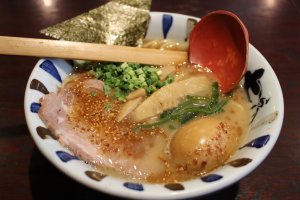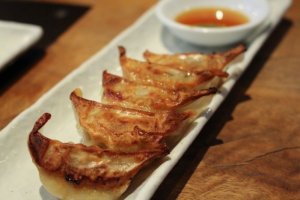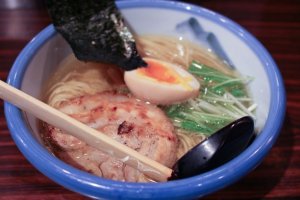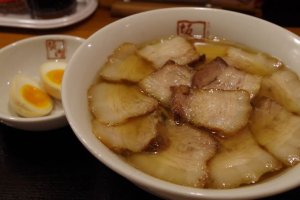Eating ramen (denoted as ラーメン or らーめん), also occasionally called “Shina soba” or “Chuuka soba” (both of which mean “Chinese soba noodles”), is something that should be on the bucket lists of almost all foreign tourists visiting Japan. Though its history is relatively short, ramen has grabbed the hearts of many a Japanese person, and has taken many foreign countries by storm in recent years as well. Delicious yet cheap without fail, ramen is not just a bowl of soup with noodles in it, now rivaling sushi as Japan’s national dish.
History
There are varying accounts on the origin of ramen, with some saying that the earliest instance of ramen in Japan occurred as long ago as 1665, when prominent daimyo Mito Mitsukuni (also known as Mito Komon) tasted a Chinese dish which featured noodles in a soup. However, it is generally believed that ramen was introduced to Japan from China when the country opened its borders during the Meiji Period, originating from the Chinese restaurants in Yokohama’s Chinatown.
“Ramen” comes from the Chinese word “lamian,” which literally means “pulled noodles.” Although the first official ramen restaurant, Rairaiken, opened in Asakusa in 1910, ramen did not become popular until after World War II, with cheap American flour being introduced to the Japanese market and soldiers stationed in China opening up ramen restaurants after returning, the dish being "Japanized" in the process. Ramen cemented its place as an important part of Japanese cuisine in 1958, when Momofuku Ando introduced instant noodles to the world, which was later named the greatest Japanese invention of the 20th century; today, the average Japanese person eats instant noodles 40 times a year. In recent decades, ramen has taken off even further in popularity, with a wide variety of types being invented and countless ramen restaurants (called ramen-ya) opening in Japan and worldwide.
Noodles
Ramen noodles usually consist of three ingredients: wheat flour, salt, and an alkaline mineral water known as kansui. Surprisingly, these yellow noodles can be served in a wide variety of ways by adjusting the ratio of the ingredients, which result in different textures. Furthermore, the noodles are cut to complement the soup, ranging from wavy to straight, and from wire-like thinness to udon-like thickness. At many ramen stores, you have the option to customize your noodles according to your preference: hosomen (thin noodles), futomen (thick noodles), or futsuu (regular).
Soups
Ramen soup is usually comprised of three elements:
-
Dashi (stock/broth)
-
The dashi serves as the base of the soup.
-
The most common dashi include those extracted from pork bone (tonkotsu) or chicken bone (torigara), which tend to give the soup a rich taste.
-
Those opting for a milder taste will usually use dashi from bonito flakes (katsuobushi), vegetables, kelp (konbu), dried sardines (niboshi), and various seafood.
-
Soups combining more than one type of dashi are not uncommon.
-
-
Tare (sauce/seasoning)
-
The tare adds flavor to the dashi. The three major types of tare are:
-
shoyu (soy sauce)
-
shio (salt)
-
miso (fermented soybean paste)
-
-
-
Koumi-abura (flavor oil)
-
Koumi-abura adds richness and umami to the soup, although some ramen-ya will opt not to use any to prevent the soup from becoming too oily.
-
Common forms of koumi-abura include pork backfat (se-abura), lard, garlic oil, and chili oil (raayu).
-
The soup is the backbone of ramen; most ramen take its name from its type of soup. Ramen chefs spend years perfecting their soup, combining various dashi, tare, and koumi-abura to ultimately find the perfect balance and complement the noodles and toppings.
Although it can be said that no two ramen are the same, they can largely be divided into four categories, based on their soup:
-
shoyu (しょうゆ/醤油)
-
Shoyu ramen gets its name from its soy sauce tare, and has a transparent brown color.
-
Often called the “standard” ramen flavor, and is the oldest and most commonly found of the four soups.
-
Usually mixed with chicken bone dashi, although combinations with tonkotsu and vegetable broth are also fairly common. Many will also be topped with pork backfat or lard.
-
Chuuka soba and Shina soba both refer to shoyu ramen.
-
-
shio (しお/塩)
-
Shio ramen gets its name from the salt used to season the dashi, usually having a clear yellow color.
-
Considered to be the mildest of the four major soups.
-
Usually combined with chicken or pork bone dashi; some places may add a dash of shoyu for some flavor as well.
-
Has a history almost as long as shoyu ramen; the city of Hakodate is especially famous for its shio ramen.
-
-
miso (みそ/味噌)
-
Miso ramen has a very tangy flavor, usually having an opaque orange-brown color.
-
Almost always combined with pork bone and vegetable broth along with backfat and lard to add richness to the soup.
-
Spicier variations which include tobanjan (spicy bean paste, also called doubanjiang) are also fairly popular.
-
Originated and made famous in Sapporo, when a customer asked a chef to put noodles into his miso soup.
-
-
tonkotsu (とんこつ/豚骨)
-
Tonkotsu soup is different from the other three in the sense that it gets its name from the predominant type of dashi, rather than the sauce or seasoning.
-
Usually has a cloudy, white color, with a creamy texture and rich taste.
-
Contains a lot of collagen.
-
The predominant type of ramen in Kyushu, with Hakata and Kumamoto being tonkotsu ramen hotspots.
-
A tonkotsu-shoyu hybrid soup (has a reddish-brown color) has become popular in recent years, especially in Yokohama and Wakayama.
-
In general, shoyu and shio ramen are mild, while tonkotsu and miso have a richer taste. However, many ramen-ya offer the option to customize the soup to match your preferences, as either kotteri (rich), assari (mild), or futsuu (regular). You may also be able to adjust the amount of oil in the soup — abura-oome (more oil), abura-sukuname (less oil), or futsuu (regular).
Toppings
No bowl of ramen is complete without toppings. A typical ramen bowl will usually include three or four default toppings; many ramen-ya will have options that include a lot of one topping on their menu (e.g. chaashuu-men, negi-ramen, etc.). You can also add extra toppings to any bowl of ramen for around 100 or 200 yen each, while some places will have a zenbu-nose (all toppings) option. Coming in a wide variety, some toppings will match certain broths more than others; for example, Sapporo's miso ramen is known for being topped with corn and butter, which are almost never included in ramen of any other broth.
Below is a list of the most common toppings.
-
chaashuu — sliced pork
-
tamago — boiled egg; can be flavored (ajitsuke tamago), or half-boiled (hanjuku tamago)
-
nori — dried seaweed
-
negi — green onions (may be spiced)
-
moyashi — bean sprouts
-
menma — bamboo shoots
-
naruto — sliced kamaboko (cured fish paste) with a spiral pattern
- horenso — spinach
Types
While ramen has become very “Japanized” over the years, ramen-ya that specialize in Chinese soup-noodle dishes have sprung up all over Japan, with the variations below being the most common. Some of these forms have even been incorporated into the menus of “standard” ramen-ya.
-
Tanmen (タンメン)
-
Noodles and vegetable (common ingredients are moyashi, cabbage, carrots, chives, and pork) stir-fry, usually in a shio soup (occasionally miso).
-
-
Tantanmen (担々麺/タンタンメン)
-
Commonly known in English as dan dan noodles, and originally a Szechuan dish, though slightly modified to fit Japanese tastes.
-
The soup contains chili oil and spicy miso, usually having a reddish color (sometimes black).
-
Often topped with bok choy and minced pork.
-
Can occasionally be served cold (hiyashi) or without soup (shiru-nashi).
-
-
Wantanmen (ワンタンメン)
-
Noodles in a shio soup topped with wonton, a type of Chinese dumpling that contains minced pork, and occasionally shrimp.
-
In recent years, ramen has diversified beyond different soups, noodles, and toppings; the following are the most popular examples.
-
Tsukemen (つけ麺)
-
A form of ramen where the noodles and soup are served separately, eaten by dipping the noodles into the soup (tsukemen literally means “dipping noodles”).
-
Tsukemen noodles are usually extremely thick, similar to udon noodles.
-
Since the soup is served separately and meant to be dipped in rather than eaten together with noodles, it will have a thicker taste; thus, it is recommended that you do not drink too much of it.
-
Some ramen-ya serving tsukemen will offer soup-wari, which is often a pork or chicken bone broth added to the soup to make it suitable for drinking after you are finished with the noodles.
-
-
Tsukemen noodles are usually served cold, although a warm option (atsumori) may be available as well.
-
A variation of tsukemen involves the noodles being served on a bamboo screen or basket, called a zaru; thus, it is called zaru ramen (like zaru soba).
-
-
Abura soba (油そば)
-
Literally “oil noodles,” abura soba is served without soup; the bowl will have a sauce containing shoyu and lard, but it allows you to tailor the taste to your own preferences by adding vinegar, chili oil, garlic, and other condiments.
-
Toppings can come in a wide variety, although the most common are chaashuu, negi, and seaweed, although many like to add a poached egg (onsen tamago).
-
Abura soba is eaten by mixing everything together, hence its alternate name maze soba (mazeru means “to mix”).
-
-
Hiyashi-ramen (冷やしラーメン)
-
Literally “chilled” ramen; served by putting ice cubes into the soup (either like a regular ramen or tsukemen-style).
-
Often served in the summer only.
-
A number of dishes are not classified as ramen, but still show heavy influences and significant similarities. The following are the most common examples:
-
Hiyashi-chuuka (冷やし中華)
-
Literally “chilled Chinese,” hiyashi-chuuka is a popular dish in the summer and is often served at ramen-ya as a “summer special.”
-
Cold noodles are served with mustard and a tare sauce made from soy sauce, vinegar, and sesame oil.
-
Toppings include omelette strips, ham, tomato, cucumber, among many others.
-
-
Nagasaki chanpon (長崎ちゃんぽん)
-
A Nagasaki speciality, chanpon is similar to tanmen, but with a different soup and ingredients.
-
Toppings include cabbage, corn, pork, seafood, moyashi, and kamaboko, with a tonkotsu soup combined with a chicken bone broth.
-
-
Okinawa soba/Yaeyama soba (沖縄そば/八重山そば)
-
Though called soba, Okinawa soba is much closer to ramen than its namesake. Fat and chewy, the noodles resemble udon more than ramen, although made in a similar manner to ramen noodles.
-
The soup is usually a combination of tonkotsu and bonito broth, giving it a transparent appearance and a mild taste.
-
Okinawa soba is usually topped with negi, beni shoga, kamaboko, and pork belly (known in the local dialect as raftee).
- Variations include those topped with soki (stewed pork ribs with the cartilage still attached) and tebichi (pig’s trotters).
-
Regional Variations
The standard bowl of ramen varies widely from region to region, with different combinations of soup, noodles, and toppings. Some of these "regional ramen," known as gotochi ramen, have become so popular that stores have opened in other cities; for example, you can find many places serving Hakata ramen in Tokyo. “Ramen theme parks,” where ramen restaurants from all over Japan gather in one area (such as Tokyo Ramen Street and the Shin-Yokohama Ramen Museum), are must-visits for ramen lovers.
The “Big 3” regional ramen are generally regarded to be Sapporo, Kitakata, and Hakata, while the “Big 4” includes Wakayama. Below is a list of the most widely-known regional variations of ramen and their special characteristics.
-
Sapporo (札幌ラーメン)
-
Being the birthplace of miso ramen, Sapporo ramen is often associated with its rich miso soup, combined with a tonkotsu broth and usually containing very thick and wavy noodles.
-
Furthermore, Sapporo’s miso ramen is topped with corn and butter (Hokkaido specialities), found on almost no other type of ramen.
-
As a countermeasure to the cold Hokkaido weather, the soup will often include lard to keep it warm.
-
Although miso may be the most popular flavor, numerous ramen-ya serving shoyu and shio ramen can also be found throughout Sapporo, as well as some places that serve all three.
-
-
Asahikawa (旭川ラーメン)
-
Often credited with starting the “regional ramen” boom, Asakihawa ramen has recently threatened Sapporo’s hold on the reputation as the top ramen in Hokkaido.
-
Its main difference from Sapporo ramen is that it is most famous for its shoyu soup, combined with broth extracted from local seafood and usually pork bones.
-
However, many aspects of Asahikawa ramen are similar to those of its Hokkaido rival; the soup will often contain lard to keep it warm, and many places will also serve miso and shio ramen.
-
-
Hakodate (函館ラーメン)
-
The home of shio ramen and one of the first Japanese cities to serve ramen, Hakodate ramen often has softer noodles and very rarely uses a seafood broth, opting for a chicken bone or pork bone base instead.
-
Unlike many other Hokkaido ramen varieties, Hakodate ramen will not contain lard, due to its southern location on the island.
-
-
Kitakata (喜多方ラーメン)
-
Located in Fukushima, Kitakata has the most ramen-ya per person.
-
Kitakata ramen is most famous for being topped with lots of chaashuu; other toppings are typically negi, menma, and naruto.
-
Usually has very thick, chewy, and wavy noodles, with shoyu soup and a tonkotsu-niboshi (dried sardine) base.
-
Another notable aspect is that it uses meltwater from Mount Iide, giving the soup a fresher taste and making the noodles more chewy.
-
-
Tokyo (東京ラーメン)
-
The “stereotypical” shoyu ramen, with a light shoyu soup and chicken broth, including chaashuu, menma, naruto, negi, and seaweed (sometimes spinach).
-
Noodles are usually on the thinner side.
-
Also known for starting tsukemen, created by the famous Taisho-ken chain, and abura soba.
-
-
Yokohama ie-kei (横浜家系ラーメン)
-
Usually has a rich tonkotsu-shoyu soup and medium thick noodles, with toppings usually consisting of spinach, chaashuu, and nori.
-
Yoshimura-ya, located in Yokohama, is called the “head temple” of ie-kei ramen; ramen chefs must train under Yoshimura-ya or one of its direct branches in order to call their ramen ie-kei.
-
-
Takayama/Hida (高山/飛驒ラーメン)
-
Ramen is so popular Takayama, when locals refer to “soba” they usually mean ramen.
-
It is one of the first “regional ramens” to exist, with a history dating back to before World War II.
-
Known for its mild, Japanese-style taste, mixing shoyu with a broth that combines chicken bones with dried sardines, bonito flakes, and vegetables.
-
Usually has thin noodles and topped with negi, chaashuu, and menma.
-
Served in smaller portions compared to other ramen (regular bowls of ramen contain around 150 grams of noodles, whereas Takayama ramen usually contains roughly 110 grams).
-
-
Wakayama (和歌山ラーメン)
-
Characterized by its tonkotsu-shoyu soup and straight thin noodles, with the standard toppings being chaashuu, negi, menma, and naruto.
-
Many Wakayama ramen-ya will pour black pepper over the ramen beforehand.
-
Wakayama culture involves eating haya-zushi (a form of fermented sushi), boiled eggs, and occasionally oden along with ramen; these are usually placed on the counter for customers to eat. Thus, Wakayama ramen is usually served in relatively smaller portions. You declare how many pieces of haya-zushi and boiled eggs you ate when you pay.
-
-
Onomichi (尾道ラーメン)
-
The soup is usually shoyu-flavored and contains lots of lard, with a dashi extracted from chicken bones and Seto Inland Sea seafood.
-
Noodles are flat and chewy, with the standard toppings being menma, chaashuu, and negi.
-
The Onomichi-style ramen was made popular by Shukaen in 1947, which has since grown to become one of the most iconic ramen-ya in Japan.
-
-
Hakata (博多ラーメン)
-
Easily distinguishable due to its creamy tonkotsu soup and straight, wire-thin noodles.
-
Due to their extreme thinness, which makes them vulnerable to absorbing too much water and hence losing its taste, Hakata ramen noodles are usually served in small portions. Thus, it’s no surprise that the kaedama (extra serving) originated in Hakata.
-
Its toppings are also unique; in addition to mainstays such as chaashuu and negi, most bowls will include kikurage (an edible fungus commonly known in English as wood ear or jelly ear). Condiments include goma (sesame seeds), beni shoga (red pickled ginger), and karashi takana (spiced mustard greens).
-
Hakata ramen is also unique for predominantly still being served at yatai (food stalls), which can be found all over Hakata and Tenjin.
-
-
Kumamoto (熊本ラーメン)
-
Has a tonkotsu soup (sometimes combined with broth from chicken bones), but with a milder taste than Hakata tonkotsu ramen.
-
Noodles are thicker and softer than those of Hakata ramen, but still relatively thin, while toppings are similar — chaashuu, negi, takana, and kikurage are common.
-
Also distinguishable from Hakata ramen due to its heavy use of garlic, in the form of fried garlic chips.
-
The world-renowned ramen chain Ajisen started in Kumamoto and serves Kumamoto ramen.
-
At the Restaurant
While they are offered at many Chinese restaurants and family restaurants, the best place to enjoy a bowl of ramen is at a legitimate ramen-ya (ramen restaurant), without a question. Ramen-ya can be found all over Japan; chances are you won’t have to walk too far to get to one, especially near train stations. Many are open until fairly late at night, as ramen is the consensus “drunk food” (colloquially called shime, or “closing”) of Japan; businessmen scrambling into ramen-ya right before closing time after having a few drinks is a common nighttime sight.
Some ramen-ya serve more than one flavor, but many will specialize in ramen of just one type of soup. Take note of the ramen-ya's speciality (soup, regional variation, etc.) before entering; most will have their menu available outside of the store. Popular ramen-ya will have a queue, so get ready to wait. Don't be discouraged, though; since ramen is a fast food, the customers will be going in and out at a quick pace, so the wait may not be as long as you'd think. Once inside, it shouldn't take much longer than 10 minutes to receive your bowl of ramen and start slurping away.
Upon entering the ramen-ya, you will notice that some will have a ticket machine right by the entrance. This is where you place your order; feed money into the machine and press the button of your desired ramen, as well as any toppings and side dishes (Note: Ticket machines at some ramen-ya may not accept 5,000 yen and 10,000 yen bills). Give the ticket(s) to the chef or one of the waiters, who may ask for your preferences regarding the noodles (thick or thin) and soup (rich or mild, amount of oil). At ramen-ya that do not have ticket machines, simply tell the chef or waiter your order. Almost all bowls of ramen will fall in between the 500~1,000 yen range (those with extra toppings will cost slightly more); its cheap price alone is enough to see why it has become so beloved in Japan.
Many ramen-ya only have counter seating, with about 10 to 20 total seats; larger ramen-ya may have tables. At each table or seat is a tray of condiments (such as garlic, pepper, and spicy miso), which you can later add to the soup to enjoy a change of flavor. Furthermore, water is self-served at most ramen-ya (although they may provide the first glass for you); use the water jug or dispenser (depending on the restaurant) if you need a refill.
The most popular “sidekick” to a bowl of ramen is gyoza (fried dumplings), often served in a plate of about 5 pieces. Gyoza sauce is almost always self-served at ramen restaurants. Usually people will combine soy sauce (shoyu), vinegar (osu), and chili oil (raayu); you will find these among the tray of condiments. Other popular side dishes include rice and fried rice (chaahan), which may be offered in half- and full-sized bowls. Adding rice to the soup (after finishing the noodles and toppings) and eating it is a popular thing to do as well. Some places will also offer donburi (rice bowls with different toppings), such as chaashuu-don and takana-don.
Etiquette & Points of Note
Generally speaking, ramen etiquette is not as strict as sushi etiquette, with most points of note being recommendations rather than explicit do's and don'ts.
-
Although there is no specific “correct” way to eat ramen, it is often recommended that you take a sip of the soup first, in order to get a general idea of the ramen’s taste.
-
Ramen chefs aim to serve their “creations” at their best condition; thus, it is advised that you do not put condiments into the ramen from the beginning, unless you are a regular. Though you are free to do so later, initially you should enjoy its taste as is.
-
Slurping the noodles is the norm in Japan, though the sight will no doubt be a major surprise for first-timers. If you don’t slurp, that’s also fine, although an added benefit of slurping is that it cools the hot noodles as they enter your mouth.
-
If the noodles are too hot, you can also place them on the spoon first, allowing them to cool, before eating them.
-
Again, there is no definite right or wrong way, but taking occasional sips of the soup and eating the toppings in between bites of the noodles is recommended, rather than eating all the noodles or toppings at once.
-
Although it is considered a compliment to the chef if you do so, it is perfectly fine that you do not drink all of the soup (most people only take a few sips), since it contains a lot of oil and sodium. As aforementioned, most people choose to just take sips of the soup in between bites of noodles, with a couple extra sips at the end.
-
If you do choose to drink the soup, lifting the bowl to your lips to do so is accepted, especially at the end (when there is nothing left other than the soup).
-
It has recommended by some that ordering "men kata" (hard) noodles delays the noodles from absorbing too much water (if the ramen-ya has the option to do so).
-
Many ramen places offer hair ties to those with long hair, as well as paper aprons for those worried about the soup spattering onto their clothes.
-
Some, but not all, ramen-ya offer kaedama, or a refill of noodles to put into the remaining soup for a few hundred yen.
- Though there is no need to rush, ramen is meant to be a fast food; finishing a bowl of ramen should not take longer than 15 minutes at most. Taking too much time will result in the noodles absorbing too much water, detracting from its taste.
Glossary
| English word/phrase | Japanese translation | Pronunciation |
|---|---|---|
| ramen | ラーメン/らーめん | ramen |
| (other names for) ramen | 中華そば/支那そば | Chuuka soba/Shina soba |
| ramen restaurant | ラーメン屋/ラーメン店 | ramen-ya/ramen-ten |
| noodles | 麺 | men |
| thick noodles | 太麺 | futomen |
| thin noodles | 細麺 | hosomen |
| soup | スープ | suupu |
| rich (taste of soup) | こってり/味濃いめ | kotteri/aji koime |
| mild (taste of soup) | あっさり/味薄め | assari/aji usume |
| pork backfat | 背脂 | se-abura |
| more oil | 油多め | abura oome |
| less oil | 油少なめ | abura sukuname |
| regular (noodles, taste of soup, amount of oil) | 普通 | futsuu |
| topping(s) | トッピング | toppingu |
| slice of pork | チャーシュー | chaashuu |
| boiled egg | 卵/玉子 | tamago |
| flavored egg | 味付け玉子 | ajitsuke tamago |
| half-boiled egg | 半熟玉子 | hanjuku tamago |
| green onions | ネギ/ねぎ | negi |
| dried seaweed | のり/海苔 | nori |
| bean sprouts | もやし | moyashi |
| bamboo shoots | メンマ | menma |
| spinach | ほうれん草 | horenso |
| all toppings | 全部のせ | zenbu-nose |
| "regional ramen" | ご当地ラーメン | gotochi ramen |
| condiments | 調味料 | chomiryo |
| soy sauce | 醤油 | ramen-ya |
| vinegar | (お)酢 | (o)su |
| chili oil | ラー油/辣油 | raayu |
| (spiced) mustard greens | (辛子)高菜 | (karashi) takana |
| pickled ginger | 紅ショウガ | beni shoga |
| sesame seeds | ごま | goma |
| black pepper | こしょう | koshou |
| rice | ご飯/ライス | gohan/raisu |
| fried rice | チャーハン | chaahan |
| gyoza (fried dumplings) | 餃子/ギョウザ | gyoza |
| refill/second serving of noodles | 替え玉 | kaedama |
































